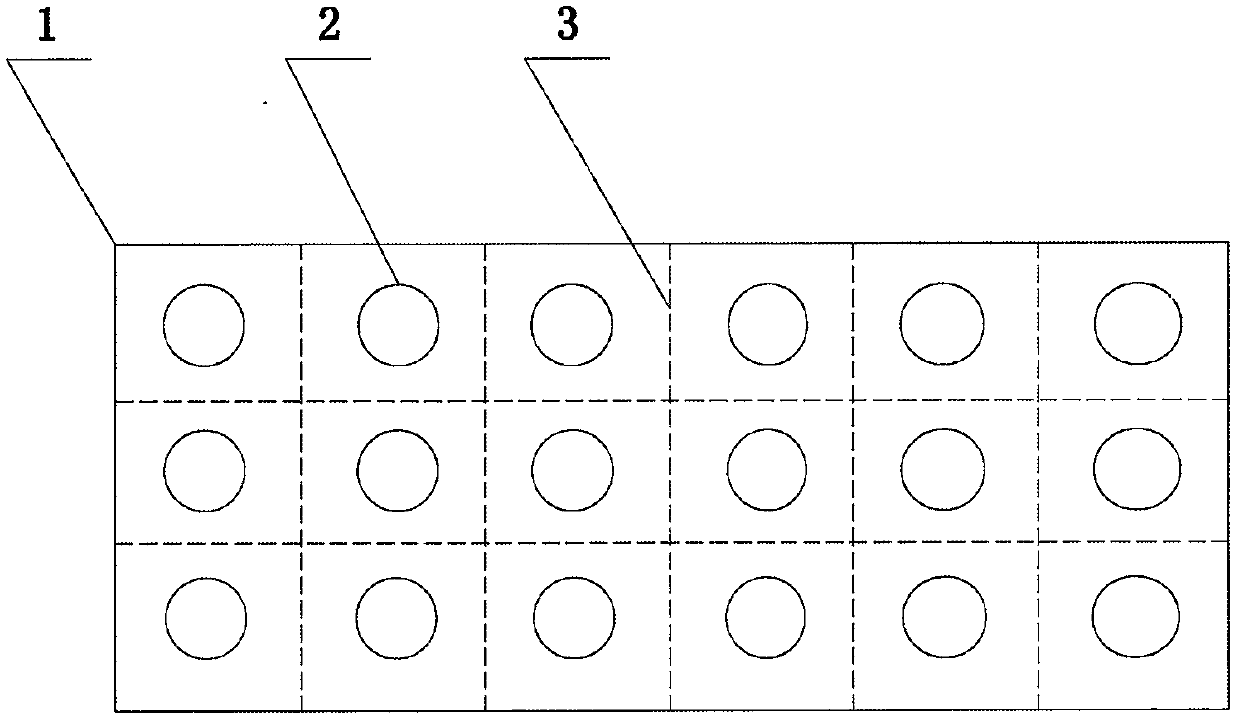A kind of dry rice transplanting method
A technology for rice and seedlings, which is applied to the field of dry rice transplanting, can solve the problems of wasting water resources, affecting rice yield, low work efficiency, etc., and achieves the effects of reducing environmental and water requirements, improving the efficiency of rice transplanting, and accelerating the growth of seedlings.
- Summary
- Abstract
- Description
- Claims
- Application Information
AI Technical Summary
Problems solved by technology
Method used
Image
Examples
Embodiment 1
[0014] Embodiment 1: a kind of dry rice transplanting method, it comprises the following steps: (1) prepare seedling raising tray; (2) paddy rice seedling raising; (3) paddy rice transplanting; Wherein,
[0015] (1) Prepare the seedling tray: the seedling tray 1 is provided with a plurality of seedling holes 2, the center spacing of the adjacent seedling holes 2 is 2 cm, and the depth of the seedling holes 2 is 2 cm; the side walls and the hole trays of each seedling hole 2 The bottoms are all provided with a plurality of through holes, and a cutting line 3 is provided on the connecting surface of adjacent seedling-raising holes.
[0016] (2) paddy rice sowing seedling: in each seedling hole 2 of seedling-raising tray 1, spread into bottom substrate, bottom substrate thickness is 0.5cm, then put 1 paddy rice seed on the bottom substrate of each seedling hole 2, and then Lay into the upper matrix, the thickness of the upper matrix is 0.5cm, after sowing, water and cultivate a...
Embodiment 2
[0019] Embodiment 2: a kind of dry rice transplanting method, it comprises the steps: (1) prepare seedling raising tray; (2) paddy rice seedling raising; (3) paddy rice transplanting; Wherein,
[0020] (1) Prepare the seedling tray: the seedling tray 1 is provided with a plurality of seedling holes 2, the center spacing of the adjacent seedling holes 2 is 4cm, and the depth of the seedling holes 2 is 3cm; the side walls and the hole trays of each seedling hole 2 The bottoms are all provided with a plurality of through holes, and a cutting line 3 is provided on the connecting surface of adjacent seedling-raising holes.
[0021] (2) Rice sowing and seedling raising: in each seedling-raising hole 2 of the seedling-raising tray 1, spread the bottom matrix, the bottom matrix thickness is 1cm, then put 1 paddy rice seed on the bottom matrix of each seedling-raising hole 2, and then spread Put into the upper substrate, the thickness of the upper substrate is 1cm, after sowing, water ...
Embodiment 3
[0024] Embodiment 3: a kind of dry rice transplanting method, it comprises the following steps: (1) prepare seedling raising tray; (2) paddy rice seedling raising; (3) paddy rice transplanting; Wherein,
[0025] (1) Prepare the seedling raising tray: a plurality of seedling raising holes 2 are arranged in the seedling raising tray 1, and the distance between the centers of the adjacent seedling raising holes 2 is 3 cm, and the depth of the seedling raising holes 2 is 2.5 cm; A plurality of through holes are arranged on the bottom of the tray, and a cutting line 3 is arranged on the connecting surface of the adjacent seedling hole.
[0026] (2) Rice sowing and seedling raising: in each seedling-raising hole 2 of the seedling-raising tray 1, spread the bottom matrix, the bottom matrix thickness is 1cm, then put 1 paddy rice seed on the bottom matrix of each seedling-raising hole 2, and then spread Put into the upper matrix, the thickness of the upper matrix is 0.5cm, after sow...
PUM
 Login to View More
Login to View More Abstract
Description
Claims
Application Information
 Login to View More
Login to View More - R&D
- Intellectual Property
- Life Sciences
- Materials
- Tech Scout
- Unparalleled Data Quality
- Higher Quality Content
- 60% Fewer Hallucinations
Browse by: Latest US Patents, China's latest patents, Technical Efficacy Thesaurus, Application Domain, Technology Topic, Popular Technical Reports.
© 2025 PatSnap. All rights reserved.Legal|Privacy policy|Modern Slavery Act Transparency Statement|Sitemap|About US| Contact US: help@patsnap.com

